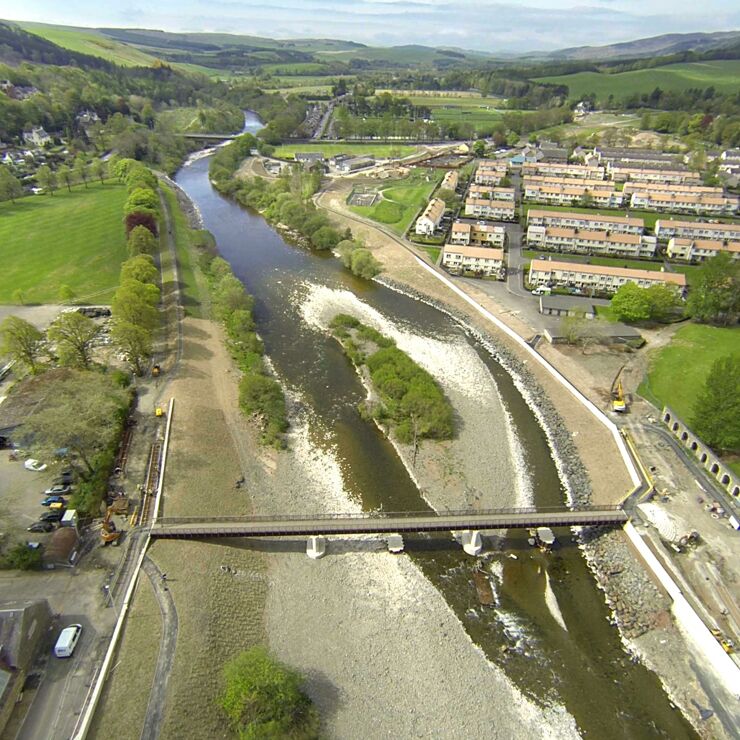
Selkirk is an old wool mill town on the banks of Ettrick Water, which is a major tributary of the River Tweed in the Scottish Borders. Following a long history of flooding, a £32 million NEC-procured scheme now provides protection to 595 properties from up to 1-in-500 years floods.
Scottish Borders Council let the scheme design to CH2M under an NEC3 Professional Services Contract (PSC) in 2009. Construction was then carried out between 2014 and 2017 by RJ McLeod under an NEC3 Engineering and Construction Contract (ECC) Option A (priced contract with activity schedule).
Construction was split into advanced, main and finishing stages. A total of 11,500m of services were diverted during the advanced works phase, including moving water and gas mains from the town’s ageing Bridge Street footbridge into a new 100 m subterranean crossing.
The main works included building 3.4km of flood walls, 3.1km of clay embankments, bentonite and sheet pile seepage cut-off walls, 310 m of rip-rap erosion protection, 6km of access paths, upstream mitigation works and five new footbridges. These included a three-span, 84m long and 1.5m higher Corten steel and timber crossing at Bridge Street.
Proactive approach
According to project manager Conor Price of CPE Consultancy, ‘After a comprehensive review of available contracts, the NEC suite was determined to be the most appropriate for both the design consultancy and construction works. This was because they promoted a proactive approach between all parties to overcome the inevitable problems that would be faced during development and delivery of this complex project.‘
He says NEC also reflected the client’s desire to advance the scheme through collaborative working and in partnership with key stakeholders and contract parties. ‘Other deciding factors included the fact that at all points in time there is clarity over the contract end date and contract value, and the use of clear and simple English by the contracts means it is easier to use for all parties involved.’
Overall Price believes use of NEC has been one of the project’s success stories. ‘It encouraged a proactive approach between all parties to collectively overcome various issues we encountered during the project. These included design amendments, construction issues and identification of defects.’
Exploiting opportunities
During the project an opportunity was identified to improve connectivity within the Riverside area by upgrading the existing road network and building a new connection road. ‘This opportunity initially derived from a major project risk that arose during construction. The mitigation strategy led to an access solution that removed the risk and simultaneously improved the town,’ says Price.
The scheme also afforded the opportunity to upgrade the town’s existing Community Recycling Centre. ‘The flexibility of the ECC allowed these significant pieces of work to be smoothly priced, incorporated, designed and then constructed as part of the contract,’ says Price
‘Both the PSC and ECC Option A contract also allowed all parties full transparency on pricing, which in turn made financial management for each a lot more simplified and manageable.’ The project team used the Cemar project management system to support contract administration.
The scheme was officially opened in February 2017 and both NEC contracts were subsequently completed on time and within budget. It was the first scheme carried out under the Flood Risk Management (Scotland) Act 2009 and, having protected the town six times by winter 2016 and delivered a benefit–cost ratio of 1.92, it has set the benchmark for all future schemes.
Benefits of using NEC
- PSC and ECC encouraged a proactive approach between all parties to overcome complications faced during construction.
- NEC early warning process enhanced risk-management processes and allowed for a partnership approach to risk reduction to keep the project on programme and reduce any potential impact on completion date.
- NEC compensation events process allowed for possible cost changes to be fully reviewed, understood and monitored before an outcome was agreed.
- NEC flexibility allowed the contract scope to be changed during the works without any ambiguity about the resulting impact on time and cost.
- ECC Option A activity schedule offered full transparency on pricing, allowing the project manager to check prices against budget.




